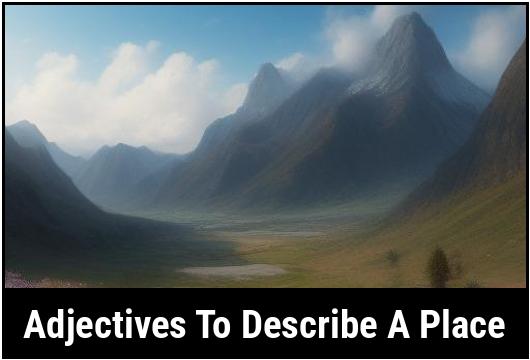- You are here:
- Home »
- adjectives
- » 51 Adjectives To Describe A Place

51 Adjectives To Describe A Place
Adjectives play a crucial role in vividly describing a place, bringing it to life in the minds of the readers. Whether it’s a bustling city, serene countryside, or majestic mountain, the right selection of adjectives can paint a beautiful and detailed picture of the place being portrayed. Through this comprehensive guide, we will explore the various types of adjectives that can be used to describe a place, the methodology behind choosing the right adjectives, and why adjectives are vital in creating a compelling depiction of a location.
Key Takeaways
- Adjectives provide detail and depth to the description of a place, creating a vivid image in the reader’s mind.
- The selection of adjectives should correspond to the specific characteristics and ambiance of the place being described.
- Using a diverse range of adjectives helps to capture the essence and atmosphere of the place effectively.
Adjectives To Describe A Place
1. Majestic
A majestic place commands respect and admiration. It exudes a sense of grandeur with its imposing presence, leaving the visitors in awe of its magnificence.
2. Tranquil
A tranquil place holds a serene and peaceful atmosphere, providing solace from the hustle and bustle of daily life. It calms the mind, allowing for relaxation and reflection.
3. Picturesque
A picturesque place appears as if it were taken straight from a postcard. It boasts extraordinary beauty, often characterized by its charming scenery or stunning views.
4. Vibrant
A vibrant place bursts with energy and liveliness. It is full of color, activity, and a sense of dynamism that creates an exciting and engaging environment.
5. Enchanting
An enchanting place possesses a magical and mystical quality. It captures the imagination, leaving a lasting impression on those who visit with its captivating charm.
6. Invigorating
An invigorating place revitalizes the body, mind, and soul. It is brimming with energy and offers a rejuvenating experience, leaving visitors feeling refreshed and renewed.
7. Quaint
A quaint place exudes an old-fashioned charm and simplicity. It often evokes a sense of nostalgia, reminding us of a time long gone.
8. Exotic
An exotic place is characterized by its uniqueness and foreignness. It offers a taste of unfamiliar cultures, traditions, and landscapes, enticing adventurers seeking new experiences.
9. Serene
A serene place is tranquil and peaceful, leaving visitors with a profound sense of calm. It provides an escape from the chaos of everyday life, allowing one to find inner peace.
10. Scenic
A scenic place offers breathtaking views and natural landscapes that leave a lasting impression. It is often characterized by its beauty, making it a delight for nature lovers and photographers.
11. Charming
A charming place possesses an irresistible appeal. It captivates visitors with its elegance, beauty, and delightful character, often leaving them enchanted.
12. Lively
A lively place is bustling with activity and energy. It is vibrant, with people and events that create a lively and engaging atmosphere.
13. Mystical
A mystical place is veiled in mystery and wonder. It holds an ethereal quality that sparks curiosity and invites visitors to explore its secrets.
14. Welcoming
A welcoming place embraces visitors with a warm and friendly atmosphere. It offers hospitality and a sense of inclusiveness that makes people feel valued and appreciated.
15. Pristine
A pristine place is exceptionally clean and untouched. It showcases untouched beauty, making it a haven for those seeking an escape from the busy and cluttered world.
16. Sophisticated
A sophisticated place exudes elegance, refinement, and a sense of class. It offers a cultured experience for those who appreciate the finer things in life.
17. Lavish
A lavish place is characterized by its luxuriousness and opulence. It indulges visitors with grandeur and extravagance, providing a taste of the high life.
18. Secluded
A secluded place is tucked away from the noise and disturbances of the world. It offers privacy and tranquility, making it an ideal retreat for those seeking solitude.
19. Historic
A historic place holds significant importance due to its past events or cultural heritage. It tells a story through its architecture, artifacts, or landmarks, connecting visitors with history.
20. Welcoming
A welcoming place embraces visitors with warmth and friendliness. It offers a sense of belonging and creates an inviting environment for people from all walks of life.
21. Blissful
A blissful place offers pure joy and happiness. It is a sanctuary for individuals seeking peace, contentment, and an escape from the worries of the world.
22. Fascinating
A fascinating place captivates visitors with its intriguing attributes and unique qualities. It sparks curiosity and inspires people to delve deeper into its wonders.
23. Remote
A remote place is far away and secluded. It offers a sense of isolation and provides an opportunity to disconnect from the world, granting a much-needed respite.
24. Welcoming
A welcoming place embraces visitors with open arms. It celebrates diversity and creates an atmosphere that encourages acceptance, fostering a sense of community.
25. Captivating
A captivating place mesmerizes visitors with its irresistible charm and allure. It holds their attention, making it difficult to look away or leave its embrace.
26. Challenging
A challenging place encourages adventurers and thrill-seekers to push their limits. It offers opportunities for excitement, and conquering its obstacles provides a sense of accomplishment.
27. Bustling
A bustling place is filled with activity and liveliness. It is characterized by crowds, noise, and movement, creating an energetic atmosphere that reflects the pulse of life.
28. Watery
A watery place is abundant in water bodies such as rivers, oceans, or lakes. It provides a refreshing environment, soothing and rejuvenating with its calming presence.
29. Magnificent
A magnificent place is awe-inspiring and breathtaking. It possesses an extraordinary beauty that is difficult to put into words, leaving visitors humbled and amazed.
30. Delightful
A delightful place brings joy and pleasure to visitors. It offers an experience filled with happiness and enjoyment, leaving them with fond memories.
31. Imposing
An imposing place commands attention with its size, structure, or presence. It inspires respect and reverence due to its formidable characteristics.
32. Welcoming
A welcoming place opens its doors to visitors, providing a warm reception and creating an environment where people feel at ease and comfortable.
33. Immaculate
An immaculate place is flawlessly clean and well maintained. It exhibits a high standard of cleanliness and care, ensuring a pleasant experience for visitors.
34. Harmonious
A harmonious place exhibits a perfect balance and unity. It enchants visitors with its seamless integration of different elements, creating a sense of tranquility.
35. Hearty
A hearty place offers a warm and hospitable experience. It provides delicious food, good company, and an atmosphere filled with laughter and joy.
36. Alluring
An alluring place possesses a powerful attraction. It entices visitors with its irresistible charm, beckoning them to explore and indulge in its offerings.
37. Luxurious
A luxurious place is synonymous with indulgence and comfort. It offers lavish amenities and an exquisite experience, pampering visitors with the utmost care.
38. Remote
A remote place is distant and isolated from civilization. It allows individuals to disconnect from the world and connect with nature, finding solace in its seclusion.
39. Enlivening
An enlivening place rejuvenates and energizes the spirit. It is filled with vitality and inspiration, filling visitors with a renewed sense of excitement and motivation.
40. Verdant
A verdant place is abundant in lush greenery and vibrant vegetation. It offers a refreshing and revitalizing environment, providing a retreat from urban landscapes.
41. Stylish
A stylish place exudes fashion and sophistication. It showcases trendiness and elegance, making it a haven for those seeking a chic and cultured experience.
42. Harmonious
A harmonious place possesses a perfect blend of elements that interact seamlessly. It creates a soothing and peaceful atmosphere that promotes a sense of balance.
43. Inspiring
An inspiring place sparks creativity and motivation. It fills visitors with a renewed sense of passion and purpose, leaving a lasting impact on their personal aspirations.
44. Enthralling
An enthralling place captures the imagination and holds visitors captive with its enchanting qualities. It engrosses their attention, leaving them fascinated and captivated.
45. Refreshing
A refreshing place offers revitalization and renewal. It rejuvenates visitors through its invigorating atmosphere, allowing for a renewed sense of well-being.
46. Harmonious
A harmonious place evokes a feeling of peace and balance. It offers a sense of tranquility, allowing visitors to find serenity amidst the chaos of life.
47. Rustic
A rustic place is associated with a simple and unsophisticated charm. It offers a return to nature and showcases the beauty of the authentic and unrefined.
48. Cultural
A cultural place celebrates the traditions, customs, and artistic expressions of a particular group. It provides insights into their way of life, immersing visitors in a rich cultural experience.
49. Dazzling
A dazzling place captivates visitors with its brilliance and radiance. It overwhelms the senses, leaving them awestruck by its mesmerizing beauty.
50. Calming
A calming place soothes and relaxes the mind. It offers a respite from the stresses of life, allowing visitors to find solace and inner peace.
51. Magical
A magical place possesses an otherworldly quality that surpasses the bounds of reality. It feels enchanting, evoking a sense of wonder and awe in all those who step into its realm.
Why Use Adjectives To Describe A Place
Adjectives are integral in the art of capturing the essence of a place through vivid and picturesque descriptors. Describing a place is not simply about stating its name or location; it involves creating a sensory experience for the reader. By engaging multiple senses through the use of adjectives, a more immersive and tangible description of the place can be achieved. For instance, instead of just mentioning "a beach," the adjectives "sandy, sun-kissed, and tranquil" can be used to evoke a complete visual and emotional image of the seaside setting.
How To Choose The Right Adjective To Describe A Place
Selecting the right adjectives to describe a place involves a thorough understanding of the location and the atmosphere it exudes. Consider the following factors when choosing adjectives:
1. Understanding The Ambiance
Before selecting adjectives, it is essential to comprehend the ambiance and character of the place. Is it bustling and vibrant, or serene and peaceful? Understanding the overall vibe of the location is crucial in choosing adjectives that accurately reflect its essence.
2. Engaging The Senses
Effective adjectives should appeal to the senses and evoke a visceral response. Consider the sounds, smells, sights, textures, and even tastes that are associated with the place. By engaging multiple senses, a more comprehensive description can be crafted.
3. Considering Cultural Significance
Depending on the cultural context, certain adjectives may carry additional connotations. It’s vital to be aware of the cultural significance of the place and use adjectives that are respectful and appropriate within that context.
4. Use Of Comparisons And Analogies
Drawing comparisons and analogies can enrich the description of a place. By likening a place to something familiar or using comparative adjectives, a more relatable and vivid image can be created.
Types Of Adjectives For Describing Place
Adjectives can be categorized into various types based on the aspects of the place they describe. The following are the types of adjectives commonly used to describe a place, along with examples of each:
1. Physical Adjectives
Physical adjectives describe the tangible attributes of a place, such as its size, shape, color, and material.
Examples
- Majestic mountains
- Vibrant city lights
- Expansive plains
- Azure waters
2. Emotional Adjectives
Emotional adjectives capture the mood or emotional impact of a place, reflecting the feelings it evokes in visitors or inhabitants.
Examples
- Enchanting forests
- Tranquil beaches
- Melancholic alleys
- Invigorating mountain air
3. Cultural Adjectives
Cultural adjectives encompass the historical, traditional, or societal aspects of a place, reflecting its heritage and customs.
Examples
- Historic landmarks
- Quaint villages
- Bohemian neighborhoods
- Multicultural cities
4. Descriptive Adjectives
Descriptive adjectives provide detailed characteristics about the landscape, terrain, or architectural features of a place.
Examples
- Rolling hills
- Majestic cathedrals
- Quaint cobblestone streets
- Lush vineyards
5. Climate-Related Adjectives
These adjectives describe the climate and weather patterns of a place, shaping the overall experience of being there.
Examples
- Sunny beaches
- Chilly mountaintops
- Tropical rainforests
- Breezy coastal cliffs
6. Comparative Adjectives
Comparative adjectives establish a relative quality by comparing the place to another entity, providing a frame of reference for the reader.
Examples
- Taller skyscrapers
- Quieter suburbs
- Busier intersections
- More picturesque landscapes
The use of adjectives in describing a place is an art that requires a deep understanding of the location, its ambiance, and the emotional response it elicits. By incorporating a diverse range of adjectives, reflecting the physical, emotional, cultural, and descriptive aspects of the place, a multifaceted and rich description can be crafted. Through the careful selection of adjectives, a writer can effectively capture the unique essence and atmosphere of a place, transporting the reader to its vivid and evocative world. Adjectives serve as the palette with which a writer can paint a vibrant and captivating picture of any location, making the description come alive in the imagination of the audience.
Examples Of Adjectives For Different Types Of Place
When it comes to describing a place, choosing the right adjectives can make all the difference in painting a vivid and detailed picture in the minds of your readers or listeners. Whether you are writing a travel article, describing a setting for a story, or simply trying to convey your experience of a place, adjectives play a crucial role in adding flavor and depth to your descriptions.
Adjectives are words that modify or describe nouns, providing more information about their qualities or attributes. They can be used to describe various aspects of a place such as its appearance, atmosphere, size, location, and more.
- Adjectives to Describe a City
- Bustling: A city characterized by a lively and busy atmosphere.
- Cosmopolitan: A city that is diverse and influenced by different cultures from around the world.
- Historic: A city with a rich history and many well-preserved historical landmarks.
- Vibrant: A city full of life and energy, with a dynamic cultural scene.
- Sprawling: A city that extends over a large geographical area.
- Modern: A city with contemporary architecture and infrastructure.
- Crowded: A city with a high population density.
- Picturesque: A visually attractive and charming city.
- Adjectives to Describe a Small Town
- Quaint: A small town with a charming and old-fashioned appeal.
- Serene: A peaceful and tranquil town.
- Idyllic: A town that embodies a simple and picturesque lifestyle.
- Close-knit: A town characterized by a strong sense of community and close relationships among its residents.
- Scenic: A town surrounded by beautiful natural landscapes.
- Intimate: A town that provides a cozy and familiar atmosphere.
- Undisturbed: A secluded town where life moves at a slower pace.
- Adjectives to Describe a Beach
- Sandy: A beach with soft sand covering its shoreline.
- Pristine: An untouched and unspoiled beach.
- Lively: A beach buzzing with activity and people.
- Tropical: A beach located in a warm and tropical climate.
- Secluded: A peaceful and isolated beach, away from the crowds.
- Palm-fringed: A beach lined with palm trees.
- Crystal clear: Describes the clarity and transparency of the water.
- Adjectives to Describe a Forest
- Dense: A forest with thick vegetation, making it difficult to see through.
- Enchanting: A forest with a magical and captivating atmosphere.
- Majestic: A forest with tall, impressive trees and a sense of grandeur.
- Serene: A calm and peaceful forest.
- Ancient: A forest that has been around for centuries, with old and wise trees.
- Mysterious: A forest that holds secrets and intrigues.
- Fragrant: A forest with a pleasant and distinct smell.
- Adjectives to Describe a Mountain
- Majestic: A mountain with awe-inspiring size and beauty.
- Snowcapped: A mountain with its peaks covered in snow.
- Steep: A mountain with a steep slope or incline.
- Towering: A mountain that rises impressively high above its surroundings.
- Remote: A mountain located in a distant and difficult-to-reach area.
- Pristine: A mountain untouched by human activity and pollution.
These adjectives provide a starting point for describing various types of places. However, it’s essential to consider the specific characteristics and qualities of each place you encounter to choose the most accurate and effective adjectives.
Common Mistakes In Using Adjectives To Describe A Place
Using adjectives to describe a place can be subjective, and there are some common mistakes to avoid to ensure your descriptions are clear and effective:
-
Using vague or generic adjectives: Describing a place as "nice," "good," or "beautiful" does not provide much insight to your readers. Instead, opt for more specific and descriptive adjectives that paint a clearer picture.
-
Overusing adjectives: Describing every aspect of a place with an adjective can make your writing repetitive and tiresome to read. Select the most essential and impactful adjectives, and use them sparingly and intentionally.
-
Neglecting to vary sentence structure: Using the same sentence structure repeatedly when describing a place can make your writing monotonous. Experiment with different sentence structures and lengths to create a more engaging and dynamic piece.
-
Failing to evoke the senses: Effective descriptions go beyond visual imagery and appeal to all the senses. Incorporate adjectives that evoke sounds, smells, tastes, and textures to create a more immersive experience for your readers.
-
Ignoring the context: The adjectives you choose should align with the overall context and tone of your piece. Consider the purpose of your description and the emotions you want to evoke, and select adjectives that support your intended message.
By being aware of these common mistakes, you can refine your descriptions and ensure they are impactful and engaging for your audience.
Using Adjectives Effectively
To use adjectives effectively when describing a place, consider the following tips:
-
Be specific: Instead of opting for generic adjectives, choose words that precisely describe the qualities of a place. For example, instead of saying a city is "beautiful," describe it as "stunning," "charming," or "picturesque."
-
Use adjectives to create vivid imagery: Adjectives can help paint a detailed picture of a place in the reader’s mind. Consider the sensory details and unique features of a place, and use adjectives to accurately convey them.
-
Consider the emotional impact: Use adjectives to evoke specific emotions or feelings related to a place. For example, you might describe a beach as "serene," "tranquil," or "invigorating" to convey the sense of calmness or energy it provides.
-
Consider the overall tone and context: Adjectives should align with the overall tone and purpose of your writing. For example, if you are describing a haunted house, you might use adjectives like "eerie," "creepy," or "spooky" to create the desired mood.
-
Vary sentence structure: Create more engaging descriptions by varying your sentence structure. Experiment with sentence lengths and use different adjectives in different parts of your description to add rhythm and flow to your writing.
-
Edit and revise: After writing your description, review it with a critical eye. Look for opportunities to replace generic adjectives with more specific and evocative ones. Consider the impact of each adjective and make revisions to enhance the overall quality of your writing.
By following these tips, you can use adjectives effectively to create vivid, engaging, and memorable descriptions of places.
Exercises And Practice
To further improve your skills in using adjectives to describe a place, here are a few exercises and practice ideas:
-
Descriptive Writing Prompts: Choose a variety of places, such as a bustling city street, a peaceful garden, an old-fashioned café, or a magical forest. Write a paragraph describing each place, focusing on using adjectives effectively to create vivid imagery.
-
Expand Your Vocabulary: Create a list of related nouns, such as beach, forest, or city. Challenge yourself to come up with as many unique and descriptive adjectives as you can for each noun. This exercise will help you expand your vocabulary and improve your adjective choices.
-
Analyze Descriptions in Literature: Read descriptive passages from books or articles that focus on describing places. Analyze the adjectives used and their impact on the overall description. Consider how the author’s choice of adjectives influences your perception of the place being described.
-
Peer Feedback: Share your descriptive writing with a peer or writing group and ask for feedback. Specifically, ask them if your adjectives effectively convey the qualities of the place and if they evoke the intended emotions or imagery.
-
Revise and Refine: Take a previously written description of a place and revise it, focusing on enhancing the use of adjectives. Experiment with different adjectives, sentence structures, and sensory language to make the description more vibrant and engaging.
Practice and repetition are key to improving your skills in using adjectives effectively. By engaging in these exercises and incorporating feedback, you can continue to refine and grow as a descriptive writer.
Conclusion
Using adjectives to describe a place is an art that takes practice and attention to detail. A well-chosen adjective can breathe life into your descriptions, allowing your readers or listeners to fully immerse themselves in the world you are describing. By selecting specific, evocative, and varied adjectives, you can create vivid and memorable descriptions that transport your audience to the places you are describing. Remember to consider the context, purpose, and emotional impact of your descriptions, and don’t be afraid to revise and refine to ensure your adjectives are used with intention and effectiveness. With time and practice, you will enhance your descriptive writing skills and captivate your audience with your ability to portray a place through vivid adjectives.
FAQS On Adjectives To Describe A Place
What Are Some Helpful Tips For Using Adjectives To Describe A Place?
When selecting adjectives to describe a place, consider the sensory details such as sights, sounds, smells, and textures. Also, think about the overall atmosphere or mood of the place and choose adjectives that convey that feeling.
How Can Using Adjectives Enhance The Description Of A Place?
Adjectives can add depth and richness to a description of a place by painting a vivid picture for the reader. They can also help to highlight unique or distinguishing features of the place.
Can The Same Adjectives Be Used To Describe Different Types Of Places?
While some adjectives may be applicable to various types of places, it’s always best to choose adjectives that are specific and appropriate for the place being described. For example, "bustling" may describe a city, but "tranquil" would better suit a beach.
Are There Any Common Mistakes To Avoid When Using Adjectives To Describe A Place?
One common mistake is to use too many adjectives or to over-exaggerate the description. It’s important to strike a balance and choose adjectives that are accurate and necessary to the overall description.
What Are Some Helpful Adjectives For Describing A Rural Community?
Some helpful adjectives for describing a rural community may include "picturesque," "quaint," "serene," "idyllic," and "bucolic." These words convey a peaceful and charming setting often found in rural areas.








